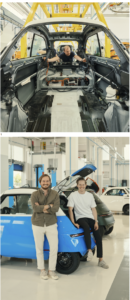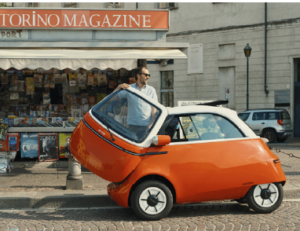Monocle, September 2023
With its loveable Microlino car, a pioneering family business is proving that the best things come in small packages.
Known for its factories and car-repair shops, Turin’s La Loggia neighbourhood is part of the Piedmontese capital’s industrial backbone. Down one of its side streets is a gated warehouse that is identical to all of the others nearby – except for a minuscule, bright-orange vehicle parked in the forecourt, glinting in the summer sun. Its popping colour and bubble shape make it look like something that you might see in a remake of The Italian Job. But it isn’t a Mini; it’s a Microlino.
Soon, Swiss brothers Merlin and Oliver Ouboter – Microlino’s CMO and COO, respectively – are welcoming monocle inside and showing us around the high-ceilinged buildings. The twentysomething co-founders are housemates in Zürich, where the company is headquartered, but these days they are in La Loggia every week to check on the vehicles rolling off the production line. Turin, with its Fiat heritage and well-established supply chains, makes perfect sense as a place to build these pod cars. So far, Microlino, which bills itself as “born in Switzerland” but “raised in Italy”, has produced 1,300 of them. It is hoping to make 3,500 this year, a number that the brand is planning to double in 2024. “The first strategy isn’t to think how big we want to be but how big the category can be,” says Oliver.
That category – of small vehicles designed to squeeze into tight urban spaces – was pioneered by the likes of Germany’s Smart. Microlino is hoping to blow the sector wide open. Technically not even a car, the two-seater is something between a motorbike and an automobile, an electric vehicle (EV) segment that is becoming increasingly popular in European cities, as well as in places such as Israel and Japan. In most European countries, you need a driving licence to operate one but it carries a motorbike number plate. Bizarrely, there’s no legal requirement for it to have a rear-view mirror.
Mini EVs are booming in popularity but their design has sometimes felt like an afterthought. Take the Citroën Ami, probably Microlino’s biggest competitor. It might be good value at about €7,000 but it looks boxy and rather plasticky. The Renault Twizy and Italy’s Birò, meanwhile, have minimalist chassis that make them resemble moon buggies (the Twizy’s side doors don’t even come as standard). Microlino saw a gap in the market.
“We wanted to do something in this small-car category,” says Merlin, as we pass Microlinos being given a final once-over under bright overhead lights. “But none of them looked like a vehicle that I would buy or drive. We thought that if we were going to do this, it would need to have some design and lifestyle appeal.”
That’s why fun and sexiness are built into the Microlino’s dna. A sliding fabric sunroof comes as standard and there are about 10 car colours to choose from, ranging from vivacious orange to toned-down and smart dark green. As we wander through the factory, which employs 150 people, an as-yet-unreleased version of a model called the Spiaggina (literally meaning “small beach”) catches our eye. It is built for summer: its window glass has been removed on the sides and back to allow in cool breezes. The Spiaggina, which comes in baby blue with blue-and-white stripes on the sunroof fabric, looks like the perfect vehicle for zipping to a post-swim aperitivo in Capri.
Microlino offers buyers the option of a two-tone colour scheme, leaving the top half of its EVs white and choosing another hue below. If that feels like a distinctly mid-20th-century touch, that’s because it is: the Ouboters acknowledge the BMW Isetta, one of the world’s first bubble cars that burst onto the scene in the 1950s, as a major influence. Indeed, the Microlino borrows the Isetta’s most iconic feature: the front-opening door. “The front door is not just a design joke,” says Merlin. “It has a purpose. You can park very close to other cars and exit onto the pavement.”
The mid-century bubble cars certainly looked good but they were also a flash in the pan, fading into obscurity almost as quickly as they arrived. So what makes Microlino think that things will be different this time around? Oliver argues that, in the past, buying a small car was simply a stepping stone to being able to afford something bigger. Now, however, people are motivated by questions such as, “How we can use space more efficiently and be more eco-friendly?” In other words, people will actually aspire to own an electric Microlino. With its price tag of between €16,500 and €18,000 (depending on where you live), it isn’t cheap for its size. But it also has a higher-quality finish than many of its competitors, with a unibody chassis made from aluminium and steel, just like a conventional car. And while many similar vehicles can only reach about 45km/h, the Microlino hits 90km/h (monocle verified this) with a battery range of up to 230km.
Microlino is part of a much larger Swiss company called Micro. Its CEO is Wim Ouboter, the father of Oliver and Merlin, and something of a legend in urbanism circles. A doyen of micromobility, he invented the much-copied kick scooter in 1999; at its height, it sold about 80,000 a day (the company still shifts more than 1.5 million units a year). Though Ouboter Sr is heavily involved with Microlino, especially when it comes to strategy, the day-to-day running is handled by his two sons.
It has been quite a ride to get to where Microlino is today. The vehicle was launched as a concept at the Geneva International Motor Show in 2016 as a possible way forward for micromobility. But the response to the design was so positive that Micro decided that it should go into production. An ill-fated joint venture, which led to lengthy legal battles, slowed progress but a settlement was reached in 2020. The Microlino 2.0, as the vehicle rolling off the production line in La Loggia is sometimes called, needed a design tweak and, also in 2020, Microlino started working with international design firm Icona, which has offices in cities from Shanghai to Los Angeles and is headquartered in Turin.
We hop into a convoy of Microlinos (what else?) to make the 20-minute journey downtown to the leafy square where Icona is based. Inside a grand palazzo d’epoca, we are welcomed into a large meeting room, where the windows have been thrown open to allow in the breeze. “The first step in the design process is always to try to go as far as we can,” says Andrea Leoncini, lead exterior designer at Icona. The brief was to update the Microlino; this involved enhancing the curves, changing the dimensions of the pod to make it higher and more spacious, and installing a modern-feeling strip light on the front of the vehicle, among other tweaks.
The vehicle had to be simple because of the limited space – a constraint that required ingenuity from the designers. A bar was placed on the inside of the front door, acting as a dashboard with a touch screen in the middle to control basic car functions. It also has a leather handle at the far end so you can lean forward and shut the door. As well as being a clever design fix, solving many problems at the same time, it’s an intentional reference to the crossbar of a scooter – a way to work some of the company’s heritage into its newest mobility baby. “I see many people trying to copy this bar now,” says Icona’s Matteo Padolfi. “You can even hang objects from it. It has a world of uses.”
Merlin and Oliver have never claimed that Microlino will solve the challenges of urban mobility in the 21st century in one fell swoop. But they do believe that they are building a small electric vehicle fit for urban use that can do many of the things that its much larger, overengineered and gas-guzzling cousins can do. Maybe it has something to do with the fact that it is easy on the eye but the Microlino seems to be the one thing that everyone can agree on. “People who say that they don’t want any cars on the road are quite open to this category, as are the car fanatics,” says Oliver. “There is common ground.”
On the road
Monocle’s Ed Stocker takes it for a spin.
Press the small button on the side of a Microlino and the front door pops open. When I climb in behind the steering wheel, it somehow feels more spacious than it looks from outside (though it’s a cosy fit once our photographer, Andrea Pugiotto, slides onto the bench seat beside me). It’s a sweltering summer day but there’s no air conditioning, so we open the sunroof and windows for a bit of the hairdryer effect. There’s a screen for the speedometer but that’s as smart as the car gets for now; a phone holder is built into the dashboard. Every vehicle comes with a portable smart speaker, which is a nice touch.
As we set off for central Turin, I notice how well it handles. There’s no power steering, so you’ll need to exert slightly more effort on a three-point turn (if you ever have to do one in a vehicle this small). And, yes, you’ll feel it when you hit a pothole (and there are several heading into Turin). But it has real power and we manage to hit the 90km/h top speed with no feeling of wobbliness (there’s also a nifty “sport” mode that gives you extra va-va-voom for hills). Apart from one petulant child who didn’t seem impressed, the Microlino is also a crowd-pleaser. Men in cars turn to check it out at traffic lights and women tell us, “Che bella!” The Microlino is popular on the road, despite not looking like a car or even driving like one. It’s a lot of fun.


